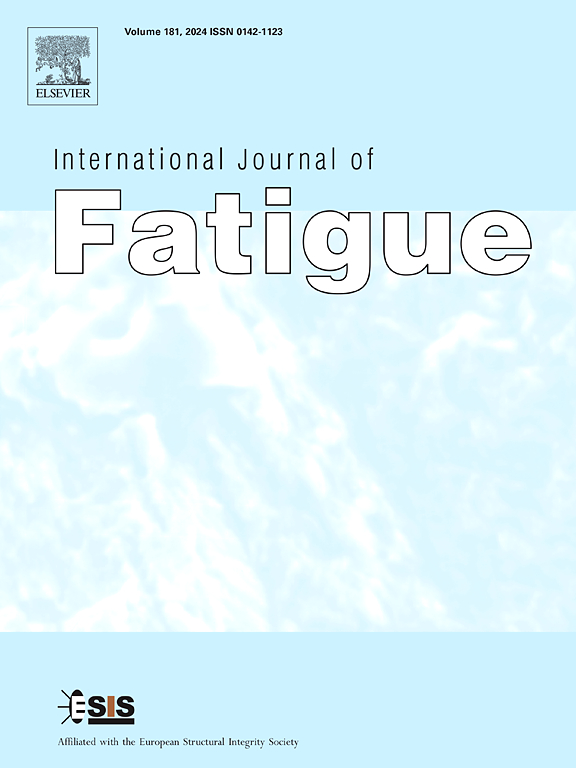Micro-pores formation mechanism and porosity on the fatigue performance of dual laser-powder bed fusion of Ti6Al4V
IF 5.7
2区 材料科学
Q1 ENGINEERING, MECHANICAL
引用次数: 0
Abstract
Porosity significantly impacts the fatigue performance and stability of dual laser additively manufactured metallic materials. This study presents a comparative analysis of the fatigue behavior of samples fabricated by single-laser powder bed fusion (SL-PBF) and dual-laser PBF (DL-PBF). It shows that porosity defects in the overlap region reduced the fatigue strength of DL-PBF samples by nearly 20 %. Micro-CT analysis revealed that micro-pores in the SL-PBF samples were predominantly located in the contour regions. Machining with a removal depth of 0.5 mm has effectively eliminated over 90 % of internal porosity defects. For monolithic specimens, increasing the sample size and reducing the layer-wise slice area can improve the sphericity of the internal defects (0.71 to 0.85) and reduce the porosity density (0.19 % to 0.011 %). Molecular dynamics simulations further examined the influence of pore size, spacing, and quantity on fatigue behavior. Larger pore sizes promote the formation of {11 1} <26> twin variants, as the pore diameter increased from 20 Å to 80 Å, the proportion of variants structure increased from 3.6 % to 11.5 %. Fatigue failure initiated from a single pore, with stress propagating towards a distant pore, forming crack paths. Stress was relieved along these crack trajectories, leading to secondary crack branches that spread into low-stress zones around other defects, which resulted in fatigue cracks with vein-like morphologies. This work provides systematic insights into the fatigue degradation mechanisms induced by porosity and offers actionable strategies for improving the fatigue resistance of multi-laser PBF components through process control.
Ti6Al4V双激光-粉末床熔合疲劳性能的微孔形成机制及孔隙率
孔隙率对双激光增材制造金属材料的疲劳性能和稳定性有重要影响。对单激光粉末床熔合(SL-PBF)和双激光粉末床熔合(DL-PBF)试样的疲劳性能进行了比较分析。结果表明,叠合区的孔隙缺陷使DL-PBF试样的疲劳强度降低了近20%。显微ct分析显示,SL-PBF样品中的微孔主要分布在轮廓区。去除深度为0.5 mm的加工有效地消除了90%以上的内部气孔缺陷。对于单片试样,增大试样尺寸和减小分层切片面积可以提高内部缺陷的球形度(0.71 ~ 0.85),降低孔隙率(0.19% ~ 0.011%)。分子动力学模拟进一步研究了孔径、间距和数量对疲劳行为的影响。较大的孔隙尺寸促进{11.2¯1}<1¯1¯26>;双变异,随着孔径从20 Å增加到80 Å,变异结构的比例从3.6%增加到11.5%。疲劳破坏从单个孔隙开始,应力向远处的孔隙传播,形成裂纹路径。应力沿着这些裂纹轨迹被释放,导致二次裂纹分支扩散到其他缺陷周围的低应力区,从而形成具有脉状形态的疲劳裂纹。本研究为孔隙率引起的疲劳退化机制提供了系统的见解,并为通过工艺控制提高多激光PBF部件的抗疲劳性提供了可行的策略。
本文章由计算机程序翻译,如有差异,请以英文原文为准。
求助全文
约1分钟内获得全文
求助全文
来源期刊

International Journal of Fatigue
工程技术-材料科学:综合
CiteScore
10.70
自引率
21.70%
发文量
619
审稿时长
58 days
期刊介绍:
Typical subjects discussed in International Journal of Fatigue address:
Novel fatigue testing and characterization methods (new kinds of fatigue tests, critical evaluation of existing methods, in situ measurement of fatigue degradation, non-contact field measurements)
Multiaxial fatigue and complex loading effects of materials and structures, exploring state-of-the-art concepts in degradation under cyclic loading
Fatigue in the very high cycle regime, including failure mode transitions from surface to subsurface, effects of surface treatment, processing, and loading conditions
Modeling (including degradation processes and related driving forces, multiscale/multi-resolution methods, computational hierarchical and concurrent methods for coupled component and material responses, novel methods for notch root analysis, fracture mechanics, damage mechanics, crack growth kinetics, life prediction and durability, and prediction of stochastic fatigue behavior reflecting microstructure and service conditions)
Models for early stages of fatigue crack formation and growth that explicitly consider microstructure and relevant materials science aspects
Understanding the influence or manufacturing and processing route on fatigue degradation, and embedding this understanding in more predictive schemes for mitigation and design against fatigue
Prognosis and damage state awareness (including sensors, monitoring, methodology, interactive control, accelerated methods, data interpretation)
Applications of technologies associated with fatigue and their implications for structural integrity and reliability. This includes issues related to design, operation and maintenance, i.e., life cycle engineering
Smart materials and structures that can sense and mitigate fatigue degradation
Fatigue of devices and structures at small scales, including effects of process route and surfaces/interfaces.
 求助内容:
求助内容: 应助结果提醒方式:
应助结果提醒方式:


